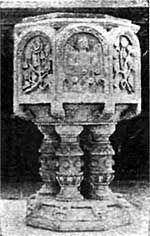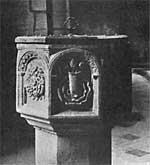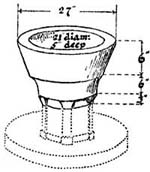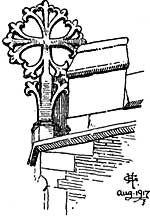In the absence of tinctures it is not surprising that guesses have been made as to the identity of the second shield on the monument. My reading of the heraldry inclines me to think that the monument records the last D'Albini, who became the Lady de Roos by marriage. The manor of Orston was held by the Crown until King Richard I. granted it to William D'Albini, to whom King John granted and confirmed it also (Thoroton). The fourth William D'Albini who held in succession died leaving his daughter Isabella sole heiress. She married Robert de Roos and conveyed the estates to him.
The figure is represented with a heart or a reliquary between upraised hands. This is intended to indicate that the heart of the individual was given to God, or as a token that a vow to Holy Church had been duly fulfilled. We know that Isabella's grandfather had built and endowed a Hospital at Bridge of Wass, between Offington and Stamford. Her father had confirmed the gift, and she herself must have been a benefactress, for she was buried "in the church attached to the Hospital of St. Mary at Newstead. A.D. 1301."
"The priory of Austin Canons, dedicated to Mary, the Blessed Virgin, by Stamford, Lines." or "Newstede by Uffington," as it was alternatively styled, has now gone almost out of recollection. If this effigy was brought to the old home at Orston at the spoliation, as I have suggested, it is the only link which remains.
Before quitting the north aisle, the two western bays of the roof thereof should be noticed. The arched principals, the beams studded with "nail-head" enrichments, and the carved pendants, go to make a fine specimen of 14th century carpentry. The nave once had a roof in correspondence if we may judge by the water tabling at the west end of the aisle: the present nave roof was put on late in the 15th century when the clerestory was added.
The sturdy seats in the north aisle illustrate the church benches of generations ago.
At the eastern end of the north aisle a blocked-up doorway which once led to the rood-loft is still in evidence. A small fragment of oak tracery from the rood-screen—a relic of by-gone days—is displayed near the south respond of the chancel arch. It was found embedded in a lath and plaster partition which separated the chancel from the nave during the latitudinarian period.

Font at Bottesford, 1563.

Font at Bottesford, 1563.

Sketch of old font.
The plain circular bowl of a "Transitional" font, although not in use is still in being, and may yet be restored. It was probably thrown out of the church during the Commonwealth, when fonts from several adjoining parishes were also degraded. Fortunately for this parish the leading families always have taken great interest in the fabric of the church, for as the Lady Roos set up an altar in her day, the Kirchevalls1—who held the manor in succession since the Reformation—set up a new font in the church in commemoration of the Restoration of Monarchy and Episcopacy.
This font is a very well-known and oft illustrated example. Dr. Cox says "the most striking Restoration font in England is the one in Orston church, Notts., which is a fine piece of carving, partly after a mediaeval model, but at the same time shewing considerable originality." In my opinion the design follows neither the mediaeval model, nor the group of dated fonts with which it is sometimes classed, for it is clearly a Stuart copy of the Tudor font at Bottesford, one of the very few fonts set up during that decadent period.
That the Bottesford font was made by the craftsman of the Renaissance who was commissioned to set up a tomb to the 2nd Earl of Rutland (obit 1563)—is placed beyond doubt by a comparison between the pedestals of font and tomb.
The font at Orston was originally placed against the western pier of the south aisle, and that is the reason why one of the panels is blank. The carving on the front panel bears an unique arrangement of three tulips in a vase issuing from the centre of a Tudor rose—probably meant to be emblematical of the Trinity. Another panel contains an inscription and date:—
GIVEn
By Mrs.
ConsTAnTiA
Kerchevall
Feb. 7.
1662.
The contrast between the virile gothic work of the pre-reformation periods, and the lifeless post-reformation work is very noticeable in the tower, which, according to a date cut in the stonework was rebuilt in 1766. I can find no record of the earlier tower, but the inference is that its removal was due to the treacherous nature of the foundation, before referred to. The Churchwardens' account book (1686-1789) contains item after item of expenditure on the steeple, the bells, the clock, and the porch. An ominous entry occurs under date October 23rd, 1722 "the Towns people of Orston are not satisfied without further advice to pay all the charges of the Steeple, without the Parish"; and again in 1749, "Paid when Mr. Gamble viewed the steeple."
Above the internal doorway leading into the tower a painted frame of the Royal Arms (King George III) is fixed. Faint traces of the Creed, the Commandments, the Lord's Prayer, and the Royal Arms are also discernible above the chancel arch.2
The belfry contains four bells dated respectively: 1599—1621—1622—1730.
Externally the effect of the church is marred by the insignificant tower. The old walls of the nave and chancel were built in thin random courses of blue lias limestone quarried locally: the dressings in Lincolnshire oolite drawn from a distance.
On the central pier of the south aisle is an old stone which contains a "scratch dial" and a consecration cross. In the re-building this stone was re-set upside down.

Orston. West end of N. Aisle.
The north aisle was underpinned and restored by the Society for Protection of Ancient Buildings in 1914, when much of the window-tracery was renewed. The embattled parapet, being ruinous, was removed. A beautiful foliated cross at the N.W. angle of this aisle is probably unique; the base of such another cross remains at the N.E. angle, but the cross head was long since removed.
I can remember making a sketch of the village stocks (January, 1874), which stood beside the churchyard gate on the south side, but they have now gone almost out of memory; while all that remains of the village cross is a block of stone which now serves as a "fender" by the roadside.
(1) "Walter Kerchevell vicar in 1515." {Torre). "John Kirchevell held the tythe as his father and grandfather before him had done." (Thoroton).
| (2) 1786. Oct. 23. | Paid Mr. Barrat for painting the King's Arms on canvas, and framing | 4 11 0 |
| Paid Mr. Brown for painting the Commandments, Creed, Lord's Prayer, and 10 verses of Matthew 5th | 4 0 0 | |
| Do. 13 Sentences of Scripture | 13 0 | |
| (Churchwarden's Account Book). |
